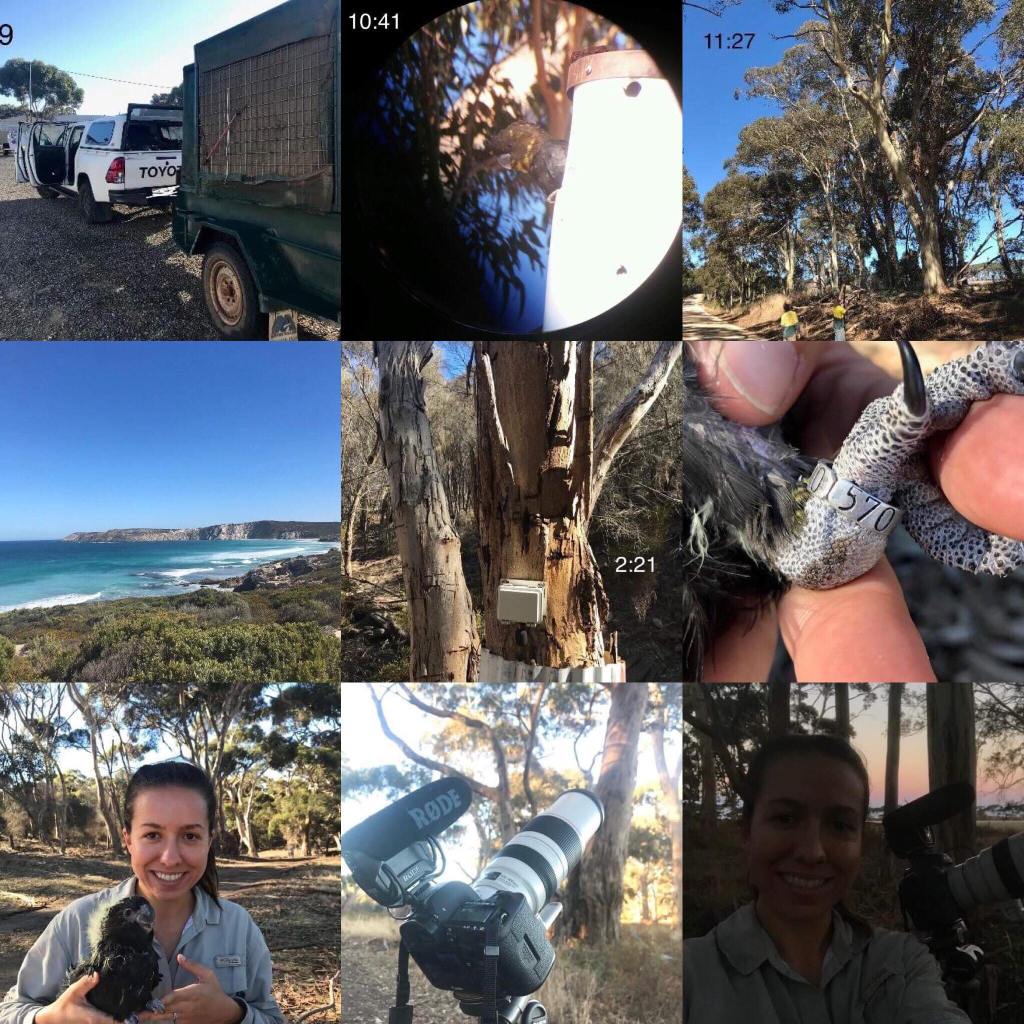Hi, I’m Daniella. I’m a conservation biologist and all-round nature fanatic, currently doing a PhD on endangered black-cockatoos in south-eastern Australia. My project is in the field of bioacoustics, which is just a fancy term for the study of animal sounds. I research the vocal behaviour of black-cockatoos, and from this am developing new ways to monitor populations with sound recorders. I focus mostly on the two most endangered populations, the Kangaroo Island glossy black-cockatoo and the south-eastern red-tailed black-cockatoo. This work takes me to some beautiful parts of this country – here’s what a typical field day on Kangaroo Island (sometimes) looks like for me.
Instagram and Facebook @daniellalteixeira and @blackcockatooproject
6:30 am: Wake up. It’s pretty dark and cold, although it’s still Autumn.
7:45 am: Grab a takeaway coffee in my KeepCup from the only place that’s open before 8am (ah, small towns!).
8:00 am: Meet the government wildlife officers at the depot. These guys have a big job of (amongst other jobs) maintaining all the island’s artificial nest boxes, especially so that possums (a major predator of glossies) can’t get in to nests.
8:19 am: Truck is loaded will all our field gear. Time to hit the road.

9:30 am: Arrive at our first site of the day. We are checking nests to see whether they are active, since glossy breeding season is now underway.
9:35 am: The first nest that we check is active. Success! I will be back to install a sound recorder soon.
10:00 am: All other nests we’ve checked so far are homing owls, but no glossies.
10:24 am: Install a sound recorder at the first nest we found. This is programmed to recorder at certain times of the day, ever day, for the entire breeding season. The recorder is positioned above the possum-exclusion collar because otherwise they chew my microphones!

10:41 am: We find another active glossy nest, this time in an artificial hollow. The glossies here on the island love these artificial nest boxes! They use them happily every year.

11:06 am: Install a sound recorder at the nest tree.

11:27 am: We’ve had a report of a nest in a small area of roadside vegetation, where there are no nest. We check a few good-looking hollows with the pole cam (18m long extendable pole camera). No sign of glossies – just lots of possums in hollows.

12:07: We’ve found a hollow that we think looks like it could be good for glossy nesting. There are plenty of possum scratch marks on the tree, though, so we install a possum collar so that if a glossy decides to nest there, they are safe.

12:46 pm: Stop at Pennington Bay for lunch. It’s pretty spectacular in all its rugged, wind-beaten beauty!

1:45 pm: Arrive at our second site for the day.
2:02 pm: I install my third sound recorder for the day, at a nest that I found was active last week. This one has a fairly large chick in it. It will probably fledge in a few weeks.

2:21 pm: Find a new active nest in an artificial hollow. Fourth sound recorder installed. This is turning out to be quite a productive day for getting sound recorders deployed!

2:40 pm: We find a nestling that is large enough to be leg-banded. Its parents are still out feeding, so we take the chance to band this one. Only a small proportion of nestlings are able to be banded.
2:52 pm: Nestling is out. The wildlife officers do the banding and take body measurements. We also determine its sex based on its plumage. This one is a male.



(One of the extremely rare opportunities I have to actually hold my study species. Photo cred: Mike Barth)
3:05 pm: One nest that was active a few days ago is now empty. We find the culprit: a possum found a gap underneath the collar. We can see scratch marks all the way up the tree. This makes us a bit sad, but then we remind ourselves how many glossies have been saved over the decades because of the work that the officers do with keeping possums out of nests.

4:30 pm: Arrive back at the depot. The officers call it day, crack a beer (wish I could stay!), while I get ready to head back out to the field for an evening session of collecting behavioural data.
5:06 pm: Arrive at a nesting area. Here I collect behavioural data by filming the birds at and near their nests. I’ve arrived a bit too late today, though, because some of the birds have already gone in the nest for the night.

5:30 pm: Plenty of activity from the nesting glossies. Best of all, it’s not windy today (a common problem) which is vital for recording good-quality sounds!
5:56 pm: Sun is almost set, birds are in their nests. That’s about all I can do here tonight

7:00 pm: Arrive home. Leftovers for dinner.
8:00 pm: Catch up on emails.
8:15 pm: Reading something totally unrelated to uni work. I like to keep things varied as much as I can. I’m currently reading a great non-fiction, Are we smart enough to know how smart animals are? by Frans de Waal, who is a wonderful primatologist. Ok, I guess that is kind of related to my field of study.
10:00 pm: Sleep. Happy.

Leave a comment